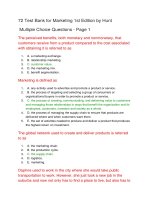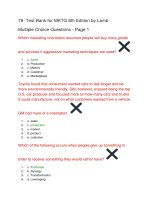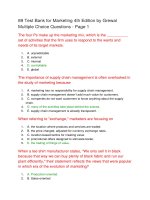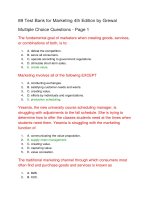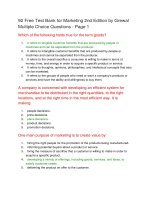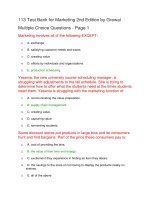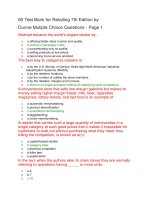Test bank for economics 5th edition by hubbard
Bạn đang xem bản rút gọn của tài liệu. Xem và tải ngay bản đầy đủ của tài liệu tại đây (1.44 MB, 191 trang )
Test Bank for Economics 5th Edition by Hubbard
Link download full:
/>-edition-by-hubbard
Download Solution Manual for Economics 5th Edition by Hubbard
Link full:
/>ics-5th-edition-by-hubbard/
Economics, 5e (Hubbard/O'Brien)
Chapter 2 Trade-offs, Comparative Advantage, and the Market System
2.1
Production Possibilities Frontiers and Opportunity Costs
1) Scarcity
A) stems from the incompatibility between limited resources and unlimited wants.
B) can be overcome by discovering new resources.
C) can be eliminated by rationing products.
D) is a bigger problem in market economies than in socialist economies.
Answer: A
Diff: 2
Page Ref: 38/38
Topic: Scarcity
*: Recurring
Learning Outcome: Micro-1: Identify the basic principles of economics and explain how to
think like an economist
AACSB: Analytic thinking
2) Tesla Motors manufacturers its cars at a plant in Fremont, California. At this plant, Tesla is
able to take advantage of the high level of technical training possessed by its American workers,
but it also sacrifices the ability to pay lower wages had it chosen to open its plant in a low-wage
country such as Mexico, India, or China. In deciding to open the Fremont plant, Tesla
A) faced no trade-offs because employing more technically-skilled workers increased efficiency.
B) faced a trade-off between higher cost and lower precision.
C) adopted a negative technological change because it chose high-skilled workers over low-paid
workers.
D) eroded some of its competitiveness in the luxury electric car market because of its increased
cost of production.
Answer: B
Diff: 2
Page Ref: 37/37
Topic: Opportunity Cost
1
Copyright © 2015 Pearson Education, Inc.
Learning Outcome: Micro-3: Discuss different types of market systems and the gains that can
be made from trade
AACSB: Analytic thinking
Special Feature: Chapter Opener: Managers at Tesla Motors Face Trade-Offs
3) The principle of opportunity cost is that
A) in a market economy, taking advantage of profitable opportunities involves some money cost.
B) the economic cost of using a factor of production is the alternative use of that factor that is
given up.
C) taking advantage of investment opportunities involves costs.
D) the cost of production varies depending on the opportunity for technological application.
Answer: B
Diff: 2
Page Ref: 39/39
Topic: Opportunity Cost
*: Recurring
Learning Outcome: Micro-1: Identify the basic principles of economics and explain how to
think like an economist
AACSB: Analytic thinking
4) The production possibilities frontier shows the ________ combinations of two products that
may be produced in a particular time period with available resources.
A) minimum attainable
B) maximum attainable
C) only
D) equitable
Answer: B
Diff: 2
Page Ref: 38/38
Topic: Production Possibilities Frontiers
*: Recurring
Learning Outcome: Micro-3: Discuss different types of market systems and the gains that can
be made from trade
AACSB: Analytic thinking
5) The production possibilities frontier model shows that
A) if consumers decide to buy more of a product, its price will increase.
B) a market economy is more efficient in producing goods and services than is a centrally
planned economy.
C) economic growth can only be achieved by free market economies.
D) if all resources are fully and efficiently utilized, more of one good can be produced only by
producing less of another good.
Answer: D
Diff: 2
Page Ref: 38/38
Topic: Production Possibilities Frontiers
*: Recurring
Learning Outcome: Micro-3: Discuss different types of market systems and the gains that can
be made from trade
AACSB: Analytic thinking
2
Copyright © 2015 Pearson Education, Inc.
6) The production possibilities frontier model assumes which of the following?
A) Labor, capital, land and natural resources are unlimited in quantity.
B) The economy produces only two products.
C) Any level of the two products that the economy produces is currently possible.
D) The level of technology is variable.
Answer: B
Diff: 2
Page Ref: 38/38
Topic: Production Possibilities Frontiers
*: Recurring
Learning Outcome: Micro-3: Discuss different types of market systems and the gains that can
be made from trade
AACSB: Analytic thinking
3
Copyright © 2015 Pearson Education, Inc.
7) The attainable production points on a production possibility curve are
A) the horizontal and vertical intercepts.
B) the points along the production possibilities frontier.
C) the points outside the area enclosed by the production possibilities frontier.
D) the points along and inside the production possibility frontier.
Answer: D
Diff: 2
Page Ref: 38/38
Topic: Production Possibilities Frontiers
*: Recurring
Learning Outcome: Micro-3: Discuss different types of market systems and the gains that can
be made from trade
AACSB: Analytic thinking
8) The points outside the production possibilities frontier are
A) efficient.
B) attainable.
C) inefficient.
D) unattainable.
Answer: D
Diff: 2
Page Ref: 39/39
Topic: Production Possibilities Frontiers
*: Recurring
Learning Outcome: Micro-3: Discuss different types of market systems and the gains that can
be made from trade
AACSB: Analytic thinking
Figure 2-1
4
Copyright © 2015 Pearson Education, Inc.
9) Refer to Figure 2-1. Point A is
A) technically efficient.
B) unattainable with current resources.
C) inefficient in that not all resources are being used.
D) the equilibrium output combination.
Answer: C
Diff: 1
Page Ref: 39/39
Topic: Production Possibilities Frontiers
*: Recurring
Learning Outcome: Micro-2: Interpret and analyze information presented in different types of
graphs
AACSB: Analytic thinking
10) Refer to Figure 2-1. Point B is
A) technically efficient.
B) unattainable with current resources.
C) inefficient in that not all resources are being used.
D) the equilibrium output combination.
Answer: A
Diff: 1
Page Ref: 39/39
Topic: Production Possibilities Frontiers
*: Recurring
Learning Outcome: Micro-2: Interpret and analyze information presented in different types of
graphs
AACSB: Analytic thinking
5
Copyright © 2015 Pearson Education, Inc.
11) Refer to Figure 2-1. Point C is
A) technically efficient.
B) unattainable with current resources.
C) inefficient in that not all resources are being used.
D) the equilibrium output combination.
Answer: B
Diff: 1
Page Ref: 39/39
Topic: Production Possibilities Frontiers
*: Recurring
Learning Outcome: Micro-2: Interpret and analyze information presented in different types of
graphs
AACSB: Analytic thinking
12) Refer to Figure 2-1. ________ is (are) inefficient in that not all resources are being used.
A) Point A
B) Point B
C) Point C
D) Points A and C
Answer: A
Diff: 1
Page Ref: 39/39
Topic: Production Possibilities Frontiers
*: Recurring
Learning Outcome: Micro-2: Interpret and analyze information presented in different types of
graphs
AACSB: Analytic thinking
13) Refer to Figure 2-1. ________ is (are) technically efficient.
A) Point A
B) Point B
C) Point C
D) Points B and C
Answer: B
Diff: 1
Page Ref: 39/39
Topic: Production Possibilities Frontiers
*: Recurring
Learning Outcome: Micro-2: Interpret and analyze information presented in different types of
graphs
AACSB: Analytic thinking
14) Refer to Figure 2-1. ________ is (are) unattainable with current resources.
A) Point A
B) Point B
C) Point C
D) Points A and C
Answer: C
Diff: 1
Page Ref: 39/39
Topic: Production Possibilities Frontiers
6
Copyright © 2015 Pearson Education, Inc.
*: Recurring
Learning Outcome: Micro-2: Interpret and analyze information presented in different types of
graphs
AACSB: Analytic thinking
15) In a production possibilities frontier model, a point ________ the frontier is productively
inefficient.
A) along
B) inside
C) outside
D) at either intercept of
Answer: B
Diff: 1
Page Ref: 39/39
Topic: Production Possibilities Frontiers
*: Recurring
Learning Outcome: Micro-3: Discuss different types of market systems and the gains that can
be made from trade
AACSB: Analytic thinking
16) Bella can produce either a combination of 60 silk roses and 80 silk leaves or a combination
of 70 silk roses and 55 silk leaves. If she now produces 60 silk roses and 80 silk leaves, what is
the opportunity cost of producing an additional 10 silk roses?
A) 2.5 silk leaves
B) 10 silk leaves
C) 25 silk leaves
D) 55 silk leaves
Answer: C
Diff: 2
Page Ref: 39/39
Topic: Opportunity Cost
*: Recurring
Learning Outcome: Micro-3: Discuss different types of market systems and the gains that can
be made from trade
AACSB: Analytic thinking
17) Pierre can produce either a combination of 20 bow ties and 30 neckties or a combination of
35 bow ties and 15 neckties. If he now produces 35 bow ties and 15 neckties, what is the
opportunity cost of producing an additional 15 neckties?
7
Copyright © 2015 Pearson Education, Inc.
A) 2 bow ties
B) 15 bow ties
C) 20 bow ties
D) 35 bow ties
Answer: B
Diff: 2
Page Ref: 39/39
Topic: Opportunity Cost
*: Recurring
Learning Outcome: Micro-3: Discuss different types of market systems and the gains that can
be made from trade
AACSB: Analytic thinking
8
Copyright © 2015 Pearson Education, Inc.
18) If the production possibilities frontier is ________, then opportunity costs are constant as
more of one good is produced.
A) bowed out
B) bowed in
C) non-linear
D) linear
Answer: D
Diff: 2
Page Ref: 39/39
Topic: Opportunity Cost
*: Recurring
Learning Outcome: Micro-3: Discuss different types of market systems and the gains that can
be made from trade
AACSB: Analytic thinking
Figure 2-2
Figure 2-2 above shows the production possibilities frontier for Mendonca, an agrarian nation
that produces two goods, meat and vegetables.
19) Refer to Figure 2-2.
A)
What is the opportunity cost of one pound of vegetables?
pound of meat
B) 1.2 pounds of meat
C)
pounds of meat
D) 12 pounds of meat
Answer: A
Diff: 2
Page Ref: 40-41/40-41
Topic: Opportunity Cost
9
Copyright © 2015 Pearson Education, Inc.
Learning Outcome: Micro-2: Interpret and analyze information presented in different types of
graphs
AACSB: Analytic thinking
Special Feature: Solved Problem: Drawing a Production Possibilities Frontier for Tesla Motors
10
Copyright © 2015 Pearson Education, Inc.
20) Refer to Figure 2-2.
A)
B)
What is the opportunity cost of one pound of meat?
pound of vegetables
pounds of vegetables
C) 1.6 pounds of vegetables
D) 16 pounds of vegetables
Answer: B
Diff: 2
Page Ref: 40-41/40-41
Topic: Opportunity Cost
Learning Outcome: Micro-2: Interpret and analyze information presented in different types of
graphs
AACSB: Analytic thinking
Special Feature: Solved Problem: Drawing a Production Possibilities Frontier for Tesla Motors
21) Refer to Figure 2-2. Suppose Mendonca is currently producing 60 pounds of vegetables
per period. How much meat is it also producing, assuming that resources are fully utilized?
A) 45 pounds of meat
B) 75 pounds of meat
C) 80 pounds of meat
D) 100 pounds of meat
Answer: B
Diff: 2
Page Ref: 40-41/40-41
Topic: Opportunity Cost
Learning Outcome: Micro-2: Interpret and analyze information presented in different types of
graphs
AACSB: Analytic thinking
Special Feature: Solved Problem: Drawing a Production Possibilities Frontier for Tesla Motors
22) Refer to Figure 2-2. If Mendonca chooses to produce 160 pounds of vegetables, how much
meat can it produce to maximize production?
A) 0 pounds of meat
B) 30 pounds of meat
C) 60 pounds of meat
D) 120 pounds of meat
Answer: A
Diff: 2
Page Ref: 40-41/40-41
Topic: Opportunity Cost
Learning Outcome: Micro-2: Interpret and analyze information presented in different types of
graphs
AACSB: Analytic thinking
Special Feature: Solved Problem: Drawing a Production Possibilities Frontier for Tesla Motors
11
Copyright © 2015 Pearson Education, Inc.
23) Refer to Figure 2-2. If Mendonca chooses to produce 120 pounds of meat, how much
vegetables can it produce to maximize production?
A) 0 pounds of vegetables
B) 60 pounds of vegetables
C) 100 pounds of vegetables
D) 160 pounds of vegetables
Answer: A
Diff: 2
Page Ref: 40-41/40-41
Topic: Opportunity Cost
Learning Outcome: Micro-2: Interpret and analyze information presented in different types of
graphs
AACSB: Analytic thinking
Special Feature: Solved Problem: Drawing a Production Possibilities Frontier for Tesla Motors
24) Refer to Figure 2-2. The linear production possibilities frontier in the figure indicates that
A) Mendonca has a comparative advantage in the production of vegetables.
B) Mendonca has a comparative disadvantage in the production of meat.
C) the tradeoff between meat and vegetables is constant.
D) it is progressively more expensive to produce meat.
Answer: C
Diff: 2
Page Ref: 40-41/40-41
Topic: Opportunity Cost
Learning Outcome: Micro-2: Interpret and analyze information presented in different types of
graphs
AACSB: Analytic thinking
Special Feature: Solved Problem: Drawing a Production Possibilities Frontier for Tesla Motors
25) A production possibilities frontier with a bowed outward shape indicates
A) the possibility of inefficient production.
B) constant opportunity costs as more and more of one good is produced.
C) increasing opportunity costs as more and more of one good is produced.
D) decreasing opportunity costs as more and more of one good is produced.
Answer: C
Diff: 2
Page Ref: 42/42
Topic: Opportunity Cost
*: Recurring
Learning Outcome: Micro-3: Discuss different types of market systems and the gains that can
be made from trade
AACSB: Analytic thinking
12
Copyright © 2015 Pearson Education, Inc.
26) Increasing opportunity cost is represented by a ________ production possibilities frontier.
A) linear
B) bowed in
C) bowed out
D) vertical
Answer: C
Diff: 2
Page Ref: 42/42
Topic: Opportunity Cost
*: Recurring
Learning Outcome: Micro-3: Discuss different types of market systems and the gains that can
be made from trade
AACSB: Analytic thinking
27) The slope of a production possibilities frontier
A) has no economic relevance or meaning.
B) is always constant.
C) is always varying.
D) measures the opportunity cost of producing one more unit of a good.
Answer: D
Diff: 1
Page Ref: 42/42
Topic: Opportunity Cost
*: Recurring
Learning Outcome: Micro-3: Discuss different types of market systems and the gains that can
be made from trade
AACSB: Analytic thinking
28) ________ marginal opportunity cost implies that the more resources already devoted to any
activity, the payoff from allocating yet more resources to that activity increases by progressively
smaller amounts.
A) Increasing
B) Decreasing
C) Constant
D) Negative
Answer: A
Diff: 2
Page Ref: 42/42
Topic: Opportunity Cost
*: Recurring
Learning Outcome: Micro-20: Apply the concepts of opportunity cost, marginal analysis, and
present value to make decisions
AACSB: Analytic thinking
13
Copyright © 2015 Pearson Education, Inc.
29) If opportunity costs are constant, the production possibilities frontier would be graphed as
A) a ray from the origin.
B) a positively sloped straight line.
C) a negatively sloped curve bowed in toward the origin.
D) a negatively sloped straight line.
Answer: D
Diff: 1
Page Ref: 42/42
Topic: Opportunity Cost
*: Recurring
Learning Outcome: Micro-3: Discuss different types of market systems and the gains that can
be made from trade
AACSB: Analytic thinking
Figure 2-3
30) Refer to Figure 2-3. Sergio Vignetto raises cattle and llamas on his land. His land is
equally suitable for raising either animal. Which of the graphs in Figure 2-3 represent(s) his
production possibilities frontier?
A) Graph A
B) Graph B
C) Graph C
D) either Graph A or Graph C
E) either Graph B or Graph C
Answer: A
Diff: 2
Page Ref: 42/42
Topic: Opportunity Cost
*: Recurring
Learning Outcome: Micro-2: Interpret and analyze information presented in different types of
graphs
AACSB: Analytic thinking
14
Copyright © 2015 Pearson Education, Inc.
31) Refer to Figure 2-3. Sergio Vignetto raises cattle and llamas on his land. A portion of his
land is more suitable for raising cattle, and the other portion is better suited for raising llamas.
Which of the graphs in Figure 2-3 represent(s) his production possibilities frontier?
A) Graph A
B) Graph B
C) Graph C
D) either Graph A or Graph C
E) either Graph B or Graph C
Answer: C
Diff: 2
Page Ref: 42/42
Topic: Opportunity Cost
*: Recurring
Learning Outcome: Micro-2: Interpret and analyze information presented in different types of
graphs
AACSB: Analytic thinking
Table 2-1
Production choices for Tomaso's Trattoria
Choice
A
B
C
D
E
Quantity of
Pizzas
Produced
48
36
24
12
0
Quantity of
Calzones
Produced
0
15
30
45
60
32) Refer to Table 2-1. Assume Tomaso's Trattoria only produces pizzas and calzones. A
combination of 24 pizzas and 30 calzones would appear
A) along Tomaso's production possibilities frontier.
B) inside Tomaso's production possibilities frontier.
C) outside Tomaso's production possibilities frontier.
D) at the horizontal intercept of Tomaso's production possibilities frontier.
Answer: A
Diff: 2
Page Ref: 39/39
Topic: Production Possibilities Frontiers
*: Recurring
Learning Outcome: Micro-3: Discuss different types of market systems and the gains that can
be made from trade
AACSB: Analytic thinking
15
Copyright © 2015 Pearson Education, Inc.
33) Refer to Table 2-1. Assume Tomaso's Trattoria only produces pizzas and calzones. A
combination of 36 pizzas and 30 calzones would appear
A) along Tomaso's production possibilities frontier.
B) inside Tomaso's production possibilities frontier.
C) outside Tomaso's production possibilities frontier.
D) at the horizontal intercept of Tomaso's production possibilities frontier.
Answer: C
Diff: 2
Page Ref: 39/39
Topic: Production Possibilities Frontiers
*: Recurring
Learning Outcome: Micro-3: Discuss different types of market systems and the gains that can
be made from trade
AACSB: Analytic thinking
34) Refer to Table 2-1. Assume Tomaso's Trattoria only produces pizzas and calzones. A
combination of 24 pizzas and 15 calzones would appear
A) along Tomaso's production possibilities frontier.
B) inside Tomaso's production possibilities frontier.
C) outside Tomaso's production possibilities frontier.
D) at the horizontal intercept of Tomaso's production possibilities frontier.
Answer: B
Diff: 2
Page Ref: 39/39
Topic: Production Possibilities Frontiers
*: Recurring
Learning Outcome: Micro-3: Discuss different types of market systems and the gains that can
be made from trade
AACSB: Analytic thinking
35) Refer to Table 2-1. Assume Tomaso's Trattoria only produces pizzas and calzones.
Tomaso faces ________ opportunity costs in the production of pizzas and calzones.
A) increasing
B) decreasing
C) constant
D) negative
Answer: C
Diff: 2
Page Ref: 39/39
Topic: Opportunity Cost
*: Recurring
Learning Outcome: Micro-3: Discuss different types of market systems and the gains that can
be made from trade
AACSB: Analytic thinking
16
Copyright © 2015 Pearson Education, Inc.
Table 2-2
Production choices for Billie's Bedroom Shop
Choice
A
B
C
D
E
Quantity of
Pillows
Produced
36
27
18
9
0
Quantity of
Blankets
Produced
0
7
14
21
28
36) Refer to Table 2-2. Assume Billie's Bedroom Shop only produces pillows and blankets. A
combination of 9 pillows and 21 blankets would appear
A) along Billie's production possibilities frontier.
B) inside Billie's production possibilities frontier.
C) outside Billie's production possibilities frontier.
D) at the vertical intercept of Billie's production possibilities frontier.
Answer: A
Diff: 2
Page Ref: 39/39
Topic: Production Possibilities Frontiers
*: Recurring
Learning Outcome: Micro-3: Discuss different types of market systems and the gains that can
be made from trade
AACSB: Analytic thinking
37) Refer to Table 2-2. Assume Billie's Bedroom Shop only produces pillows and blankets. A
combination of 9 pillows and 14 blankets would appear
A) along Billie's production possibilities frontier.
B) inside Billie's production possibilities frontier.
C) outside Billie's production possibilities frontier.
D) at the vertical intercept of Billie's production possibilities frontier.
Answer: C
Diff: 2
Page Ref: 39/39
Topic: Production Possibilities Frontiers
*: Recurring
Learning Outcome: Micro-3: Discuss different types of market systems and the gains that can
be made from trade
AACSB: Analytic thinking
17
Copyright © 2015 Pearson Education, Inc.
38) Refer to Table 2-2. Assume Billie's Bedroom Shop only produces pillows and blankets. A
combination of 5 pillows and 21 blankets would appear
A) along Billie's production possibilities frontier.
B) inside Billie's production possibilities frontier.
C) outside Billie's production possibilities frontier.
D) at the vertical intercept of Billie's production possibilities frontier.
Answer: B
Diff: 2
Page Ref: 39/39
Topic: Production Possibilities Frontiers
*: Recurring
Learning Outcome: Micro-3: Discuss different types of market systems and the gains that can
be made from trade
AACSB: Analytic thinking
39) Refer to Table 2-2. Assume Billie's Bedroom Shop only produces pillows and blankets.
Billie faces ________ opportunity costs in the production of pillows and blankets.
A) increasing
B) constant
C) decreasing
D) negative
Answer: B
Diff: 2
Page Ref: 39/39
Topic: Production Possibilities Frontiers
*: Recurring
Learning Outcome: Micro-3: Discuss different types of market systems and the gains that can
be made from trade
AACSB: Analytic thinking
40) An inward shift of a nation's production possibilities frontier can occur due to
A) a reduction in unemployment.
B) a natural disaster like a hurricane or bad earthquake.
C) a change in the amounts of one good desired.
D) an increase in the labor force.
Answer: B
Diff: 2
Page Ref: 43/43
Topic: Economic Growth
*: Recurring
Learning Outcome: Micro-3: Discuss different types of market systems and the gains that can
be made from trade
AACSB: Analytic thinking
18
Copyright © 2015 Pearson Education, Inc.
41) An outward shift of a nation's production possibilities frontier represents
A) economic growth.
B) rising prices of the two goods on the production possibilities frontier model.
C) an impossible situation.
D) a situation in which a country produces more of one good and less of another.
Answer: A
Diff: 1
Page Ref: 43/43
Topic: Economic Growth
*: Recurring
Learning Outcome: Micro-3: Discuss different types of market systems and the gains that can
be made from trade
AACSB: Analytic thinking
42) Economic decline (negative growth) is represented on a production possibilities frontier
model by the production possibility frontier
A) shifting outward.
B) shifting inward.
C) becoming steeper.
D) becoming flatter.
Answer: B
Diff: 1
Page Ref: 43/43
Topic: Economic Growth
*: Recurring
Learning Outcome: Micro-3: Discuss different types of market systems and the gains that can
be made from trade
AACSB: Analytic thinking
43) Without an increase in the supplies of factors of production, how can a nation achieve
economic growth?
A) by producing more high-value goods and less of low-value goods
B) through technological advancement which enables more output with the same quantity of
resources
C) by lowering the prices of factors of production
D) by increasing the prices of factors of production
Answer: B
Diff: 2
Page Ref: 43/43
Topic: Economic Growth
*: Recurring
Learning Outcome: Micro-17: Explain the effects of the factors of production, factor demand,
and factor supply and labor in factor markets
AACSB: Analytic thinking
19
Copyright © 2015 Pearson Education, Inc.
44) Which of the following would shift a nation's production possibilities frontier outward?
A) discovering a cheap way to convert sunshine into electricity
B) an increase in demand for the nation's products
C) a decrease in the unemployment rate
D) a law requiring workers to retire at age 50
Answer: A
Diff: 2
Page Ref: 43/43
Topic: Economic Growth
*: Recurring
Learning Outcome: Micro-3: Discuss different types of market systems and the gains that can
be made from trade
AACSB: Analytic thinking
Figure 2-4
Figure 2-4 shows various points on three different production possibilities frontiers for a nation.
45) Refer to Figure 2-4. A movement from X to Y
A) could be due to a change in consumers' tastes and preferences.
B) could occur because of an influx of immigrant labor.
C) is the result of advancements in food production technology only, with no change in the
technology for plastic production.
D) is the result of advancements in plastic production technology only, with no change in food
production technology.
Answer: B
Diff: 2
Page Ref: 43/43
Topic: Economic Growth
*: Recurring
Learning Outcome: Micro-2: Interpret and analyze information presented in different types of
graphs
AACSB: Analytic thinking
20
Copyright © 2015 Pearson Education, Inc.
46) Refer to Figure 2-4. A movement from Y to Z
A) represents an increase in the demand for plastic products.
B) could occur because of general technological advancements.
C) is the result of advancements in food production technology.
D) is the result of advancements in plastic production technology.
Answer: D
Diff: 2
Page Ref: 43/43
Topic: Economic Growth
*: Recurring
Learning Outcome: Micro-2: Interpret and analyze information presented in different types of
graphs
AACSB: Analytic thinking
47) Refer to Figure 2-4. Consider the following events:
a. an increase in the unemployment rate
b. a decrease in a nation's money supply
c. a war that kills a significant portion of a nation's population
Which of the events listed above could cause a movement from Y to W ?
A) a, b and c
B) a and b only
C) a and c only
D) a only
E) c only
Answer: E
Diff: 2
Page Ref: 43/43
Topic: Economic Growth
*: Recurring
Learning Outcome: Micro-2: Interpret and analyze information presented in different types of
graphs
AACSB: Analytic thinking
48) Refer to Figure 2-4. Consider the following movements:
a. from point V to point W
b. from point W to point Y
c. from point Y to point Z
Which of the movements listed above represents economic growth?
A) a, b, and c
B) b and c only
C) a only
D) b only
Answer: B
Diff: 2
Page Ref: 43/43
Topic: Economic Growth
*: Recurring
Learning Outcome: Micro-2: Interpret and analyze information presented in different types of
21
Copyright © 2015 Pearson Education, Inc.
graphs
AACSB:
Analytic thinking
22
Copyright © 2015 Pearson Education, Inc.
49) Refer to Figure 2-4. Consider the following events:
a. a decrease in the unemployment rate
b. general technological advancement
c. an increase in consumer wealth
Which of the events listed above could cause a movement from V to W ?
A) a only
B) a and b only
C) b and c only
D) a, b, and c
Answer: A
Diff: 2
Page Ref: 43/43
Topic: Economic Growth
*: Recurring
Learning Outcome: Micro-2: Interpret and analyze information presented in different types of
graphs
AACSB: Analytic thinking
50) Refer to Figure 2-4. Consider the following events:
a. a reduction in the patent protection period to no more than 2 years
b. a war that destroys a substantial portion of a nation's capital stock
c. the lack of secure and enforceable property rights system
Which of the events listed above could cause a movement from W to V?
A) a only
B) a and b only
C) a and c only
D) b and c only
E) a, b, and c
Answer: C
Diff: 2
Page Ref: 43/43
Topic: Economic Growth
*: Recurring
Learning Outcome: Micro-2: Interpret and analyze information presented in different types of
graphs
AACSB: Analytic thinking
51) Refer to Figure 2-4. A movement from ________ could occur because of an influx of
immigrant labor.
A) W to V
B) X to W
C) W to Z
D) Y to W
Answer: C
Diff: 2
Page Ref: 43/43
Topic: Economic Growth
*: Recurring
23
Copyright © 2015 Pearson Education, Inc.
Learning Outcome: Micro-2: Interpret and analyze information presented in different types of
graphs
AACSB: Analytic thinking
24
Copyright © 2015 Pearson Education, Inc.
52) Refer to Figure 2-4. A movement from ________ is the result of negative technological
change in plastic production.
A) V to X
B) X to W
C) W to Z
D) Z to Y
Answer: D
Diff: 2
Page Ref: 43/43
Topic: Economic Growth
*: Recurring
Learning Outcome: Micro-2: Interpret and analyze information presented in different types of
graphs
AACSB: Analytic thinking
53) Refer to Figure 2-4. Consider the following events:
a. a decrease in the unemployment rate
b. an increase in a nation's money supply
c. an influx of immigrant workers
Which of the events listed above could cause a movement from X to Z?
A) a, b and c
B) a and b only
C) a and c only
D) a only
E) c only
Answer: E
Diff: 2
Page Ref: 43/43
Topic: Economic Growth
*: Recurring
Learning Outcome: Micro-2: Interpret and analyze information presented in different types of
graphs
AACSB: Analytic thinking
54) Refer to Figure 2-4. Consider the following movements:
a. from point V to point W
b. from point W to point Y
c. from point Y to point Z
Which of the movements listed above represents advancements in technology with respect to
only plastic production?
A) a, b, and c
B) b and c only
C) b only
D) c only
Answer: D
Diff: 2
Page Ref: 43/43
Topic: Economic Growth
25
Copyright © 2015 Pearson Education, Inc.


